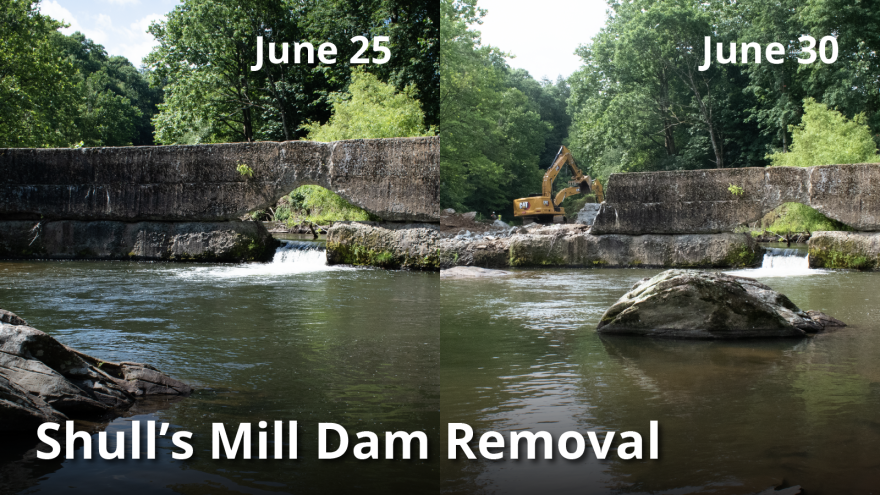The Shull’s Mill Dam is an obstruction, but it’s been a long time since it was water-tight. Water flowed from an eye-shaped hole in the middle of the dam, a remnant of flooding during the 1940s. Now, the rest of the dam will come down during the next couple weeks.
“It’s so deteriorated, we’re going to have to handle it a different way and pull it over in sections,” said Chad Shirley, a facilities operations specialist with the U.S. Fish and Wildlife Service.
He is leading the U.S. FWS Aquatic Restoration Team, which has removed at least fifteen other obstructions in the southeast region. Besides the dam’s state of degradation, he said Shull’s Mill has another special consideration.
The structure overlooks a small pool, which has become a prime habitat for the country’s largest salamander, the eastern hellbender.
The nonprofit American Rivers spearheaded the dam removal alongside MountainTrue, which includes Watauga Riverkeeper Andy Hill. Last week, the two groups coordinated the search and rescue of eight hellbenders from the area surrounding the dam. They’re going to continue monitoring these amphibians in their new home, miles downstream.

The two organizations orchestrated the removal of the nearby Ward’s Mill Dam three years ago — once Shull’s Mill comes down, the Watuaga will flow uninterrupted for 78 miles from Boone to Tennessee.
“These dams will never grow back,” said Erin Singer McCombs, American Rivers’ Southeast conservation director. “This is permanent good on the landscape.”
The Aquatic Restoration Team will use woody debris from the dam to stabilize the riverbanks in places where they have deteriorated. The rebar will be recycled, but much of the concrete waste will be hauled to an offsite disposal location.
Once the dam is removed, the free-flowing Watauga River will bolster the already substantial outdoor recreation economy. The river already attracts anglers and paddlers from across the state. In Watauga County, outdoor recreation generates $236 million in economic activity each year.
The two excavators brace their buckets against the top of the dam. The hydraulic hammer, which resembles a giant hole puncher, contracts alongside the excavators, pulling the concrete away from the pool below.
Dam deconstruction at Shull’s Mill will take a couple weeks. More than 2,000 dams have been removed across the country — 80 dams came down in the last year. That sounds like a lot, but American Rivers aims to remove 30,000 dams by 2050.
Even that number is only a drop in the mill pond. In North Carolina alone, there are about 28,000 dams, only a small percentage of which still function. The N.C. legislature designated $7.2 million to remove dams in Western North Carolina — this is the first project funded in part through that money.
“One thing that really strikes me is how easily the dam face came down,” McCombs said. “I feel really grateful that we were able to get this public safety hazard off the landscape before any kind of catastrophic failure.”

The Aquatic Restoration Team shifted the water flow away from the construction site, but a torrent of groundwater appears under the hydraulic hammer as it breaks the concrete into smaller pieces.
A murky cloud of sediment flows downstream — one of the short-term impacts of the removal, according to Andrea Leslie, an aquatic biologist with the N.C. Wildlife Resources Commission.
“One of the concerns about removal of a dam like this is that chunks could fall downstream and then you got to dig that up,” Leslie said.

Dam removal will leave behind some localized bruising, like resetting a dislocated shoulder. However, in the long run, the Watauga will be a better habitat for all species.
“As you move downstream in the Watauga River, you see fewer and fewer hellbenders,” Leslie said.
She said this is due to issues such as bank erosion, warming waters, and pollution. Once the dam is removed, volunteers will come out for about a week, planting thousands of native plants a day with an emphasis on species that help native pollinators.
These trees will shade the stream, hold the bank in place, and filter runoff as it flows towards the river. This will protect the aquatic species that move in after the dam comes down.
“Once the dam is breached and fish can move through, fish will begin moving through,” Hill said.
The hardier invertebrates, like crayfish, will make their way over. Caddisflies and other insects that indicate good water quality will move in next as the river recovers. The hellbenders will follow after that.
